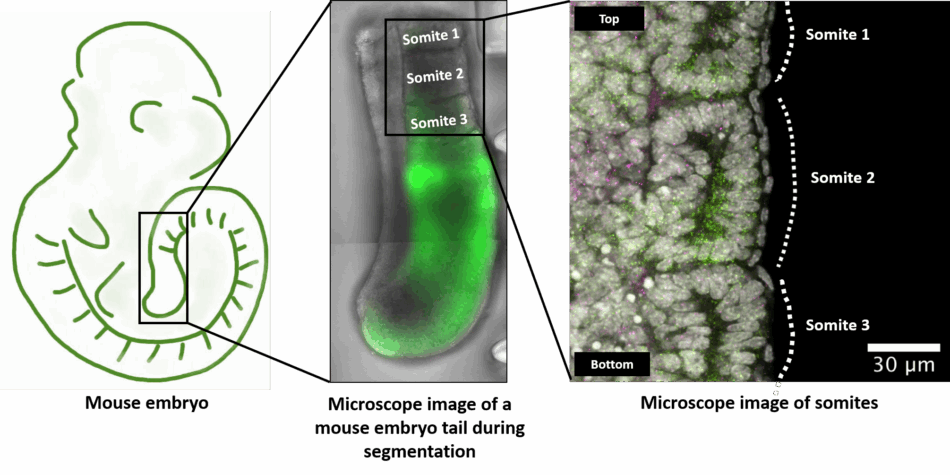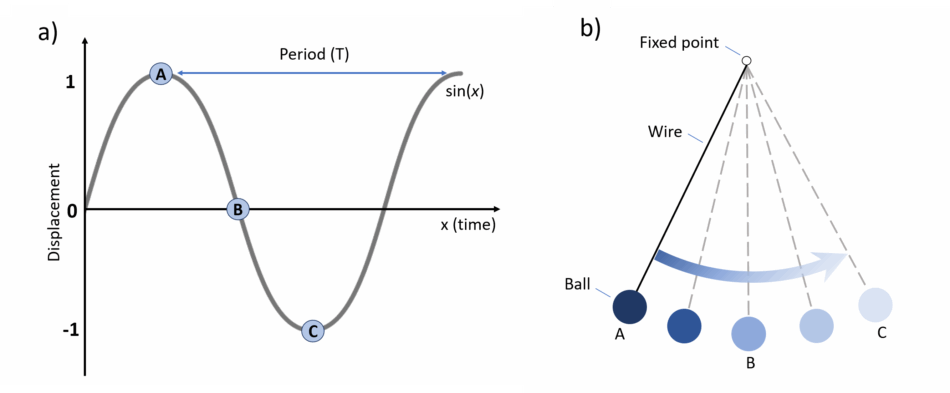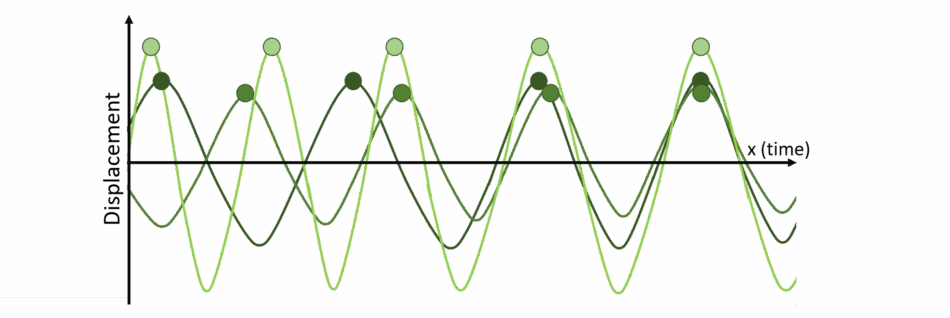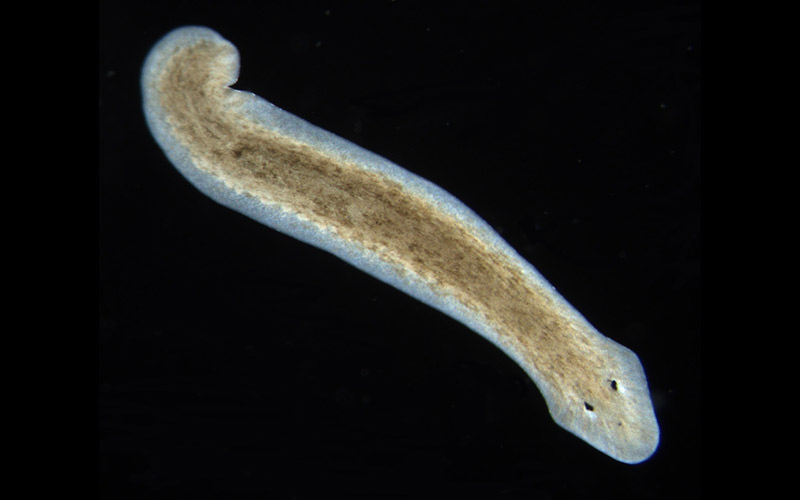
From birds to photons: collective phenomena in materials science
All together now: discover how the collective behaviour of atoms, humans, and birds inspire researchers to make new light-emitting materials and devices.

Tick tock: Did you know that there are secret clocks ticking inside living organisms, including us? Let’s dive into the science of biological oscillators.
Have you ever wondered why some plants, like mimosa (Mimosa pudica), open their leaves during the day and close them during the night? Or what regulates our heartbeats? Nature is full of rhythmic patterns like these, the basis of which are biological oscillations. An oscillation is a periodic, repeating change in any quantity or measurement, typically over time, that moves around a stable central value. Oscillations that occur in living systems, from molecules to organisms, are called biological oscillations. Their roles range from regulating celluar processes to shaping our daily behaviours. Let’s explore the physical and biological mechanisms that many biological oscillators share, so we can understand how these oscillations arise.
Biological oscillators have a wide range of functions that help cells keep time, respond to their environment, or coordinate complex processes. The cell cycle oscillator is a molecular timing system that ensures that our DNA divides in time before the cells physically separate from each other to form two daughter cells. Glycolytic oscillations are fluctuations in glucose products that coordinate energy production with energy demands in contracting muscle cells. The circadian clock is a biological clock that synchronizes our physiological processes, such as eating and sleeping patterns, blood pressure, and hormonal levels, with day–night cycles. As different as these examples sound, at the cellular level they all rely on two main principles: a negative feedback loop and a time delay.
To build the ticking heart of a biological oscillator, you need a negative feedback loop. Negative feedback allows a system to maintain equilibrium when a change happens to it by triggering responses that dampen that change. It differs from positive feedback, which amplifies changes that happen to a system. Figure 1 shows the mechanism of a negative feedback loop with activating and repressing components, which are molecules produced by the cells, such as proteins, ions, products of metabolism, etc. The repressor and activator engage in an interaction loop in which the activator stimulates the repressor, which in turn suppresses the activator. When the activator is suppressed for long enough, the repressor’s effect drops, which then allows the activator to turn on again.
A real-world example is a thermostat that detects when a room gets cold and then turns on the heating. The temperature decrease that triggers the thermostat to start increasing the temperature is the negative feedback that returns the system (the room) back to equilibrium (normal temperature). Once the room gets hot enough, the thermostat is triggered to turn off again.
Finally, a time delay within the negative feedback loop is also necessary for the oscillations to occur. In cells, this time delay usually arises from how long it takes for the activator and repressor molecules to be produced, accumulated, and degraded. The delay prevents the system from quickly reaching equilibrium by creating a temporal division between the activation and repression, thus making the system oscillate. In the absence of a time delay, the system cannot oscillate because it rapidly reaches equilibrium, stabilizing at a steady state (figure 2).

Let’s consider the example of a biological clock that is crucial during embryo development in vertebrates: the segmentation clock. In biology, development is the process by which a single cell grows and matures into a full organism with patterned tissues and organs. All processes during development need to be carefully coordinated in time and space for the organism to develop properly, and the segmentation clock is responsible for this coordination during spine development.
The segmentation clock is a molecular oscillator located in the tail tissue of vertebrate embryos.[1] It controls the periodic formation of blocks of cells called somites that will later develop into vertebrae and associated tissues, such as skeletal muscle and cartilage. The main clockmakers of this system are genes of Her/Hes family. These genes produce proteins that rhythmically activate and repress their own production by binding with a time delay to the genes that encode them, thus creating oscillations within cells. The oscillations are coupled between cells to create a periodic wave that rhythmically sweeps through the tissue, determining where and when and how often each new somite is created, a process known as segmentation (figure 3).

Similar to the segmentation clock, the circadian clock also ticks because activator proteins turn on genes that produce their own repressors, which eventually shut down the activators. Other cellular oscillators have different clockmakers, but they also maintain the oscillatory loop through activation and repression. As we can see, time-delayed negative feedback loops are essential for all self-sustaining oscillations.
Biological oscillations also share a remarkable ability to interact with one another – a phenomenon that becomes clearer when examined through the lens of physics.
Just like a swinging pendulum, a biological oscillator is a system that is periodically displaced and returned to equilibrium, repeating its cycle in regular intervals. One complete back-and-forth cycle determines the period (T ) of the oscillation, whereas the number of cycles per second is called frequency (f ). Heartbeats, which can have a period of milliseconds, belong to some of the fastest biological oscillations, whereas animal migration is an oscillation with a period of about one year, which is why it is called circannual rhythm (from Latin, circa: around and annus: year).
Mathematically, a periodic oscillation can be represented as a rotation around a circle or projected along an x-axis as a sine or cosine wave. For simplicity, the wave representation is shown here. Wave progression shows us how far away from the zero equilibrium the particle will be at a certain time, reaching maximum displacement at 1 and minimum displacement at −1. Specific locations within this oscillatory wave can be defined by measuring the phase of oscillation. Points A, B, and C in figure 4 represent different places on the periodic wave, and thus different phases.

Understanding phase makes it easy to compare oscillations, describe how much one oscillation is ahead or behind another one, or even synchronize them. The phenomenon of synchronization arises when single oscillating units align their phases with each other (figure 5). In North America and Southeast Asia entire groups of fireflies (Photinus carolinus or Pteroptyx malaccae) synchronize their flashing, creating wonderful flashing displays. Each firefly is aware of the fireflies in its proximity and adjusts the timing of its flashing, overlapping the phase of its oscillatory behaviour with its neighbours, so that eventually the whole group becomes synchronized. Yeast cells can also align the phases of their glycolytic oscillations until they synchronize and can communicate with each other through synchronized signals. In this way, they can collectively respond to their environment and manage food resources better.

You can create your own synchronous system with two or more metronomes, a few cylindrical cans or bottles, and a flat board. Balance the board on top of the bottles, so it can roll easily. Set each metronome to tick at the same tempo, but out of sync, thus creating two oscillators that tick at the same period but out of phase. The metronomes tick independently. Now observe what happens if you place the metronomes on the board facing perpendicular to the rolling direction.

Can you explain how the metronomes become synchronized? What do you think is happening with the phases of the oscillations (metronomes)?
When oscillators adjust their phase not to each other, like fireflies or yeast cells do, but instead to an external oscillator, the process is called entrainment. Imagine the periodic motion of a girl oscillating on a swing at her own rate. If an adult starts pushing the swing (an external cue), the original period of the swing will adjust itself to the new period dictated by the adult’s pushes. External cues that can entrain a system are called zeitgebers (from German, Zeit: time and Geber: giver). For example, almost all organisms have an internal biological oscillation that can adjust itself to the day–night rhythm, called the circadian clock. In the case of circadian clocks, light serves as the zeitgeber, with the day–night cycle acting as the external oscillation that entrains our internal clock. This explains why we experience jet lag when our internal rhythm falls out of sync with it. Chronic circadian misalignment, for example, in people who work only night shifts, is associated with metabolic, cardiovascular, and mood disorders.[1]
Understanding how biological oscillators work, synchronize, and communicate with each other allows us to understand biological functions and behaviours better. Firefly synchronization has led to the development of mathematical models that reflect synchrony in neural systems.[2] Entrainment has been used by scientists to study how oscillators interact together, as well as to manipulate the phase and periodicity of biological oscillations. By using entrainment as a tool to study the segmentation clock in mice, we have learned that the phase relationship of oscillations is important for the correct formation of mouse spines.[3] Furthermore, in our most recent research, we have entrained the segmentation clock with pulses of glucose, which opens new ways of thinking about how periodic changes of nutrients in the environment of embryos can affect their development.[4] All this research could help us understand and prevent developmental disorders and birth defects, or learn how diseases, such as diabetes, could be connected to these oscillatory processes. From flickering fireflies to the precise segmentation in developing embryos, the physics of synchrony and entrainment can help us decode the rhythms of living things and perhaps teach us how to tune them ourselves.
Activator: A molecule that increases the activity of another molecule, for example, by activating a gene, by producing a protein, or by increasing the efficiency of a reaction.
Biological molecular oscillator: A system in which small biomolecules, such as genes, proteins, or metabolites, interact in a rhythmic way, so that their activity and/or levels rise and fall cyclically, regulating biological processes that need precise timing.
Cardiovascular: Related to heart and blood vessels.
Development: The process of growth and change of a living organism, which starts with a fertilized egg and ends when the organism is fully formed into a baby, plant, or animal. During development, cells divide, multiply, move, and group together to form tissues, organs, and body parts.
Entrainment: A special form of synchronization, during which the rhythm of one or more oscillations aligns to an external rhythm.
Equilibrium: A balanced, stable state with no net change over time.
Neural system: A network of nerve cells in the body.
Oscillator: A system, object, or process that undergoes regular, repeating cycles over time.
Repressor: A molecule that decreases the activity of another molecule, for example, by shutting down a gene, by degrading a protein, or by decreasing the efficiency of a reaction.
Segmentation: The arrangement of an organism’s body during development into repeating body parts or segments, such as muscles, bones, and vertebrae, until a full, structured body is built.
Somite: The rhythmic activity of the segmentation clock coordinates cells to group together into somites, blocks of cells that form regularly along the length of a developing embryo. As development progresses, somites become specialized structures such as vertebrae and muscles.
Synchronize: To align the rhythm of two or more processes to each other, so that they occur at the same time.
[1] Vosko AM, Colwell CS, Avidan AY (2010) Jet lag syndrome: circadian organization, pathophysiology, and management strategies. Nat Sci Sleep 19: 187−98. doi: 10.2147/NSS.S6683
[2] McCrea M, Ermentrout B, Rubin JE. (2022) A model for the collective synchronization of flashing in Photinus carolinus. J R Soc Interface 19: 20220439. doi: 10.1098/rsif.2022.0439
[3] Sonnen KF et al. (2018) Modulation of Phase Shift between Wnt and Notch Signaling Oscillations Controls Mesoderm Segmentation. Cell 172: 1079-1090. doi: 10.1016/j.cell.2018.01.026
[4] Miyazawa M et al. (2024) Glycolysis–Wnt signaling axis tunes developmental timing of embryo segmentation. bioRxiv. doi: 10.1101/2024.01.22.576629.

All together now: discover how the collective behaviour of atoms, humans, and birds inspire researchers to make new light-emitting materials and devices.

Camelids are famously robust and useful animals. Surprisingly, their unusual antibodies are just as sturdy and are now revolutionizing medical science.

Meet the planarian, a fascinating flatworm with incredible biological abilities and unique and surprising ways to respond to various stimuli.